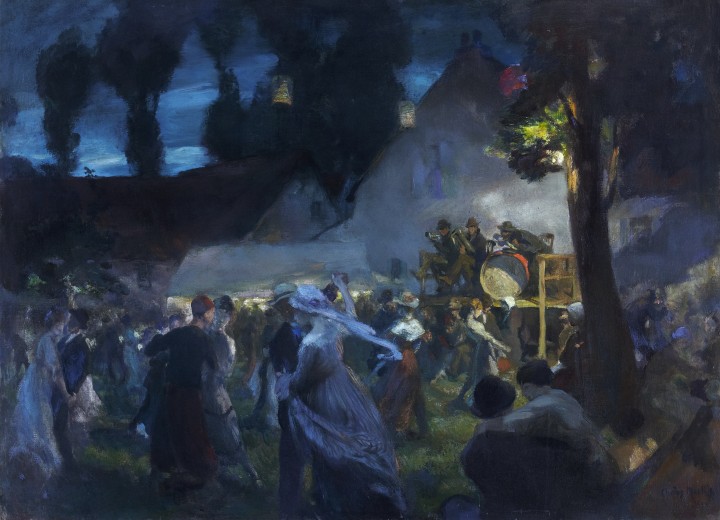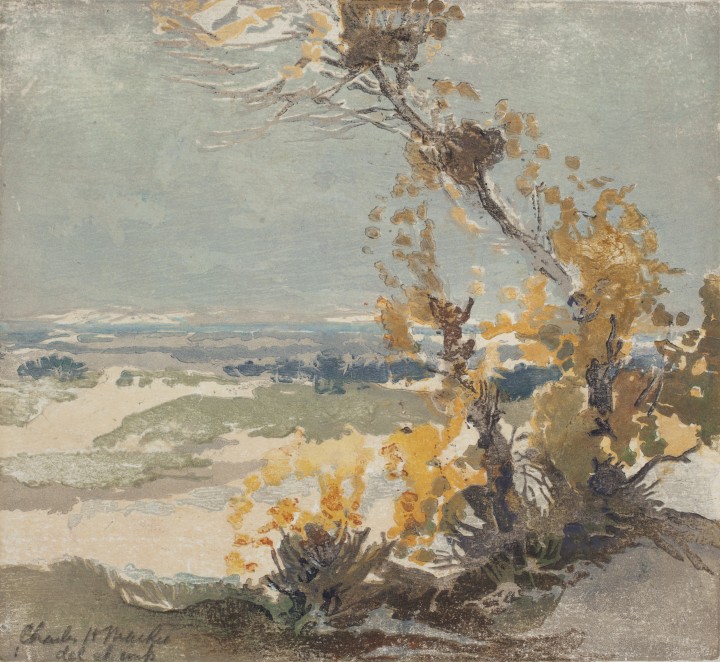Scottish Art News
Latest news
Magazine
News & Press
Publications
Charles Mackie: Colour and Light
By Susan Mansfield, 21.05.2021

The painting she had inherited from an aunt intrigued Pat Clark. She liked the scene, of a canal in Venice, and wanted to know more about the artist, Charles H. Mackie, but could find out very little. It was the start of a journey which would take her to France and Australia, and would lead to her writing the first book on the little known Scottish artist.
She hopes that the largest exhibition of Mackie’s paintings for 100 years, which has just opened at Edinburgh’s City Art Centre (CAC), will introduce an “unjustly forgotten” artist to new audiences. The show is the result of years of planning and detective work by Clark and CAC curator Dr Helen Scott, and many of the works have not been exhibited in public for decades.
The variety of work in the show pays tribute to an artist who worked in a range of styles and was not afraid to embrace the avant-garde. A contemporary of the Glasgow Boys, he was the only Scottish artist to spend time with the French symbolists in Paris, meeting Vuillard and Gauguin. He painted art nouveau murals for Patrick Geddes, became a master in woodblock printing and produced outstanding landscape paintings which celebrate colour and light.
Dr Helen Scott believes Mackie’s versatility could be one reason he is less well known today than he should be. “It was a strength but, in terms of his legacy, it’s been a bit of a setback because he doesn’t have one single recognisable style or medium. His archive has been scattered, and some of his finest works have been destroyed or lost. It’s really nice to be able to bring so many works together to give a sense of his versatility because it’s really impressive.”
 Charles H. Mackie, Picardy Poplars, 1902. Courtesy of Perth Museum & Art Gallery.
Charles H. Mackie, Picardy Poplars, 1902. Courtesy of Perth Museum & Art Gallery.
Mackie was born in 1862 in Aldershot where his father, a serving soldier, was stationed, but spent most of his life in Edinburgh. He studied at the Trustees Academy in Edinburgh with Glasgow Boy Edward Atkinson Hornel, who remained a lifelong friend. An early landscape done in Hornel’s home town of Kirkcudbright shows how close Mackie’s work was at this point to the kailyard realism of the Glasgow Boys.
However, everything changed when, in 1892, on a walking holiday in northern France with his new wife, Anne, he met the artist Paul Sérusier, a leading figure in the symbolist movement. Invited to Paris by Sérusier the following two summers, he met the other artists in the group known as Les Nabis, spent time with Vuillard and visited Paul Gauguin in his studio. The impact on Mackie’s own work was immediate: always interested in colour, he now began working with a richer palette and simplifying forms in the symbolist style.
Mackie’s brush with the avant-garde caught the eye of Patrick Geddes who commissioned him to paint important murals in his apartment complex at Ramsay Garden, and to create cover artwork and illustrations for his journal, The Evergreen. He also worked on an important series of murals in the Celtic revival style for Pitreavie Castle near Dunfermline which have since been lost.
In the closing years of the 19th century, when the circle of artists around Geddes began to disperse, Mackie returned to easel painting, keen to sell work to support his family. He focussed on landscapes in Scotland and Yorkshire, in the area around Whitby. It was there he met the young artist Laura Knight, who would later credit him as one of her most important teachers.
 Charles H. Mackie with the painting For Harvest Festival, 1907, unknown photographer. Image courtesy of Bill Mackie.
Charles H. Mackie with the painting For Harvest Festival, 1907, unknown photographer. Image courtesy of Bill Mackie.
Always keen to travel, he went to Spain in 1904, where he painted prolifically in watercolours and oils, challenging himself to capture scenes out of doors in low light. Sadly, many of these works, having been bought by an art dealer from San Francisco, were lost in the fire which followed the 1906 earthquake in that city. A rare survivor (The Little Dancers, Madrid) is in the CAC show.
Ever since his visit to Paris, he had collected Japanese prints and experimented with coloured woodblock printing. Spending years refining his technique, he produced masterful work in this medium. Helen Scott says: 'His aim was to produce woodblocks that felt like watercolours, and I think he does achieve that, they have a spontaneity and fluidity to them.'
Having attracted the support of several wealthy patrons, including Andrew Carnegie, he was able to make longer trips abroad, and in 1908, the family visited Venice for the first time. Mackie’s wife Anne would later write: 'The crowning moment of this aesthetic life came when Venice was revealed to him.'
Pat Clark believes Mackie’s Venice paintings, such as La Piazzetta (a study for which is in the Fleming Collection) and Musica Veneziana, are among his finest works. She says: 'What he finds in Venice is a quality of light which allows him to put into practice all his ideas about colour and light.'
 Charles H. Mackie, La Musica Veneziana, 1909. City Art Centre, Museums & Galleries Edinburgh
Charles H. Mackie, La Musica Veneziana, 1909. City Art Centre, Museums & Galleries Edinburgh
Even though he enjoyed considerable success with his Italian paintings and woodblock prints, Mackie was never one to rest on his laurels. When appointed a visiting tutor for the RSA Life School in 1909, he produced a large body of life studies and several major paintings. In 1914, already unwell with cancer, he accepted a commission to create a sculpture, a fountain featuring a nymph and faun, which is now in the National Museum of Scotland. He is believed to have said on his deathbed in 1920: 'Just give me two more years at the easel.'
Pat Clark says: 'He never stopped in his artistic travels, he pushed himself, he never turned down a challenge. He was very much his own man, and in his lifetime he was recognised as having a unique talent. He didn’t deserve to fall into the crevices of history. It has become my life’s mission to awaken the world to the joy of Charles Mackie again.'
Charles H. Mackie: Colour and Light at City Art Centre runs until 10 October. Admission free, see website for visiting information.




